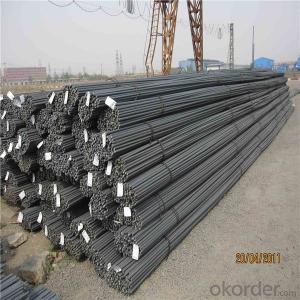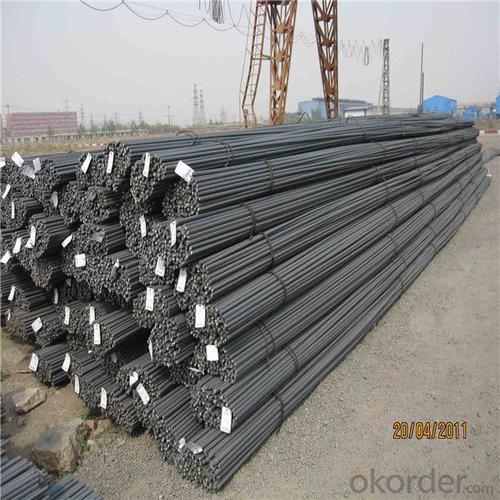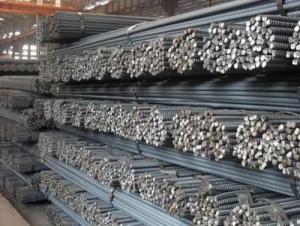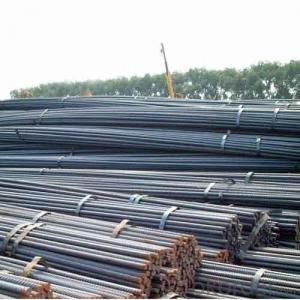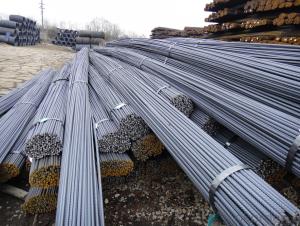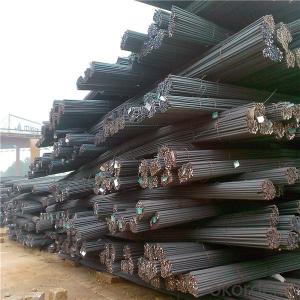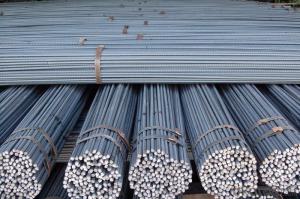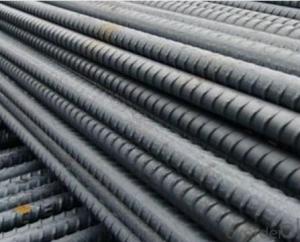Construction iron rod hot rolled for sale
- Loading Port:
- Tianjin
- Payment Terms:
- TT OR LC
- Min Order Qty:
- 1000 m.t.
- Supply Capability:
- 17497 m.t./month
OKorder Service Pledge
OKorder Financial Service
You Might Also Like
Specification
Steel rebar is bars of steel commonly used in construction, especially for reinforcing concrete structures such as driveways,
foundations, walls, and columns. These bars come in different sizes and strength grades, and can be smooth or may include
deformations that provide greater adhesion for concrete poured over the bars. When used in poured concrete, the bars are
typically placed in a grid pattern, the concrete poured over them, and then readjusted to maintain the proper shape while the
concrete sets. Steel rebar can be purchased from a number of manufacturers and is often found at construction retailers or
large hardware stores
Product Description :
Chemical composition (%): | Steel | C | Si | Mn | P | S | Ceq | ||||
HRB335 |
0.25 |
0.80 |
1.60 |
0.045 |
0.045 | 0.52 | |||||
HRB400 | 0.54 | ||||||||||
HRB500 | 0.55 | ||||||||||
Mechanical properties | Steel | Rel/ MPa | Rm/ MPa | A/ % | Agt/ % | ||||||
≥ | |||||||||||
HRB335 | 335 | 455 | 17 |
7.5 | |||||||
HRB400 | 400 | 540 | 16 | ||||||||
HRB500 | 500 | 630 | 15 | ||||||||
Package: | Standard export packing or as customer's request | ||||||||||
Application: | Construction, building, bridge, road. ect | ||||||||||
Payment terms | 1).100% irrevocable L/C at sight. | ||||||||||
Delivery time | 15-30 days after receipt of L/C or deposit by T/T | ||||||||||
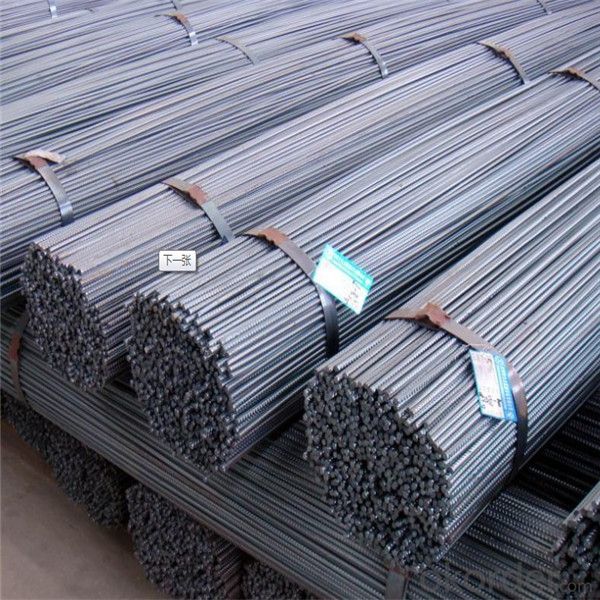
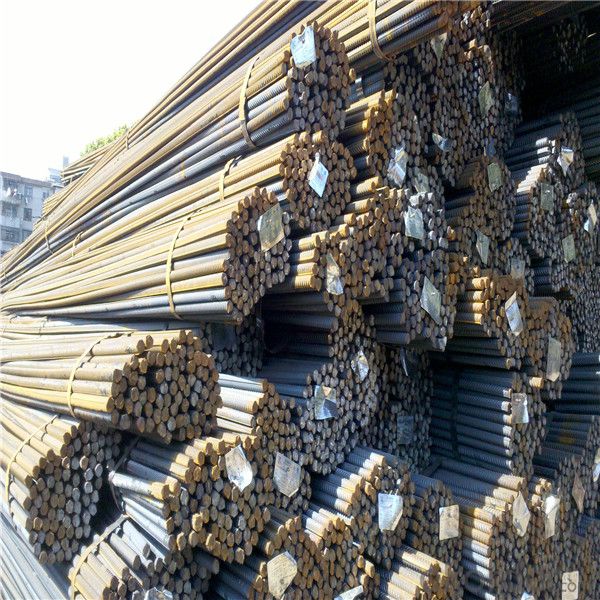
Features
1、Pure steel quality, stable chemical contents, small tolerance.
2、Constant Quality, good drawing performance.
3、High dimension accuracy degree, accuracy degree of Level C up to 80%, smooth surface, less scale, easy to be pickled.
4、Automatic bundling with 4 lines by Machine in tidy and good looks
5、Big high quality percentage, small coil percentage, and heavy coil weight for Hard Coil.
6、High sorbitizing percentage.
Packing:
In bundles, each bundle weight 3.5 tons. Load by container or by bulk verssel.
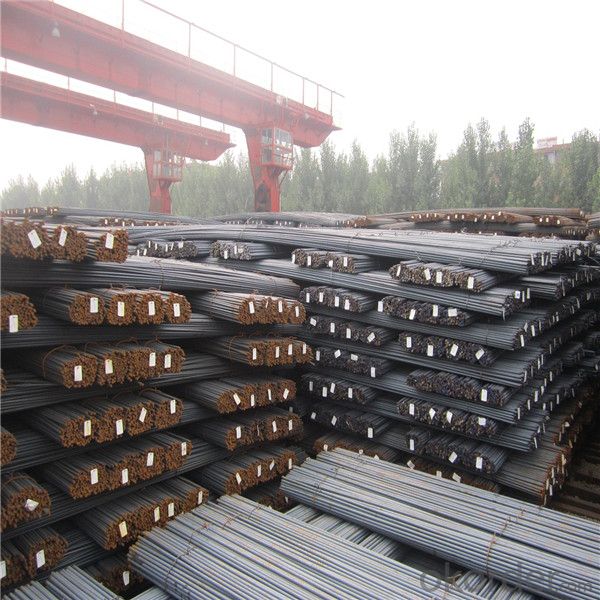

FAQ:
1.Q: What's your MOQ(minimum order quantity)?
A: One full container, mixed acceptable .
2. Q: What's your packing methods?
A: Packed in bundle or bulk ..
3. Q: How can I buy CNBM products in my country?
A:Please send us an inquiry or email ,we will reply to you if there is distributor in your country
4. Q: Can we visit your factory?
A: Warmly welcome. Once we have your schedule, we will arrange the professional sales team to follow up your case.
5. Q: How long does it take to get the product if i place an order?
A:With the process of your requirements,we will pack and deliver in 3-7 days. If it is by sea shipment,it will take 15-45 days depending on different locations
- Q: How are steel rebars protected during the concrete pouring process?
- During the concrete pouring process, steel rebars are protected in several ways to ensure their longevity and structural integrity. Firstly, before the concrete is poured, the rebars are carefully cleaned to remove any rust, dirt, or other contaminants that could compromise the bond between the rebar and the concrete. This is typically done by using a wire brush or other mechanical means. Once the rebars are cleaned, they are usually coated with a protective layer or coating. One common method is to apply an epoxy coating to the rebars. This coating acts as a barrier, preventing moisture and chemicals from reaching the steel and causing corrosion. Epoxy coatings are often used in high-risk environments such as marine structures or areas with high chloride content. Another method of protection involves using corrosion inhibitors. These inhibitors are added to the concrete mix, which then forms a protective layer around the rebars. The inhibitors work by reducing the corrosive effects of chloride ions, oxygen, and other chemicals that could lead to corrosion. Additionally, during the pouring process, it is important to ensure proper concrete cover over the rebars. Concrete cover refers to the thickness of the concrete layer between the surface and the rebar. Adequate concrete cover helps protect the rebars from exposure to moisture, chemicals, and other environmental factors. To achieve the required concrete cover, steel stirrups or spacers are placed around the rebars to maintain a specific distance between the rebar and the formwork. This ensures that the concrete is evenly distributed around the rebars, providing them with the necessary protection. In summary, steel rebars are protected during the concrete pouring process through various methods such as cleaning, applying protective coatings, using corrosion inhibitors, and maintaining proper concrete cover. These measures help to prevent corrosion and ensure the durability and strength of the reinforced concrete structure.
- Q: What are the guidelines for proper anchoring of steel rebars in concrete structures?
- Proper anchoring of steel rebars in concrete structures is crucial for ensuring the structural integrity and stability of the construction. The guidelines for proper anchoring of steel rebars are as follows: 1. Embedment length: The rebars should be embedded in the concrete for a certain length to provide sufficient bond strength. The required embedment length is determined by the design specifications and depends on factors such as rebar diameter, concrete strength, and load conditions. 2. Lap length: When connecting two rebars, a minimum lap length is required to ensure continuity of reinforcement. The lap length is determined based on the rebar diameter, concrete strength, and structural design requirements. 3. Concrete cover: Adequate concrete cover should be provided to protect the rebars from corrosion and fire. The concrete cover is the distance between the outer surface of the rebars and the nearest concrete surface. It depends on factors such as the environment, fire resistance requirements, and durability considerations. 4. Spacing and arrangement: The rebars should be spaced properly and arranged as per the structural design requirements. The spacing between rebars depends on the structural load and design specifications. Improper spacing can lead to inadequate reinforcement and compromise the structural strength. 5. Proper positioning: The rebars should be positioned accurately as per the design drawings and specifications. They should be placed in the concrete formwork before pouring the concrete to achieve the desired structural behavior. Improper positioning may lead to rebar misalignment or inadequate concrete cover. 6. Mechanical anchorage: Mechanical anchorage devices such as rebar couplers, anchor bolts, or hooks can be used to enhance the anchoring of rebars in concrete structures. These devices provide additional reinforcement and prevent slippage or pull-out of the rebars under load. 7. Quality control: Regular inspection and quality control measures should be implemented to ensure adherence to the anchoring guidelines. This includes checking rebar dimensions and spacing, embedment depth, concrete cover, and ensuring proper installation techniques. It is important to note that these guidelines may vary depending on the specific project requirements, local building codes, and design specifications. Therefore, it is essential to consult the structural engineer or refer to the relevant building codes and standards for the specific guidelines applicable to each construction project.
- Q: What are the factors that determine the spacing and diameter of steel rebars?
- The factors that determine the spacing and diameter of steel rebars include the structural requirements of the project, the load-bearing capacity needed, the type of concrete being used, and the design codes and regulations in place. Additionally, factors such as the spacing of adjacent rebars, the concrete cover thickness, and the construction process also play a role in determining the spacing and diameter of steel rebars.
- Q: How do steel rebars impact the overall flexibility of a structure?
- Steel rebars impact the overall flexibility of a structure by providing reinforcement and increasing its strength. The addition of steel rebars enhances the structural integrity, allowing the structure to withstand external forces and stresses without deformation or failure, thus improving its overall flexibility and durability.
- Q: How can steel rebars be recycled after their service life?
- Steel rebars can be recycled after their service life by first removing them from the concrete structures. The rebars are then collected and taken to a recycling facility where they undergo a process called steel rebar recycling. In this process, the rebars are cleaned, sorted, and shredded into small pieces. These pieces are then melted down in a furnace and transformed into new steel products or rebars, which can be used for various construction purposes. Recycling steel rebars not only conserves natural resources but also helps to reduce waste and minimize environmental impact.
- Q: Can steel rebars be used in bridge deck construction?
- Yes, steel rebars can be used in bridge deck construction.
- Q: How are steel rebars marked for identification?
- Steel rebars are typically marked for identification through a combination of embossed letters or numbers, paint markings, or colored plastic caps. These marking methods allow for easy identification and sorting of rebars based on their dimensions, grade, and manufacturer.
- Q: Can steel rebars be bent or shaped during construction?
- Yes, steel rebars can be bent or shaped during construction. They are commonly used in reinforced concrete structures and can be bent to fit the required design, shape, or structure.
- Q: Can steel rebars be used in the construction of residential towers?
- Yes, steel rebars can be used in the construction of residential towers. Steel rebars are commonly used as reinforcement in concrete structures, including residential buildings, to increase their strength and durability. They provide the necessary support to withstand the structural loads and ensure the overall stability of the building.
- Q: How do steel rebars affect the overall cost-effectiveness of a structure?
- Steel rebars play a crucial role in enhancing the overall cost-effectiveness of a structure. These reinforcement bars are widely used in construction projects to provide strength, durability, and stability to concrete structures. By incorporating steel rebars, the lifespan of a structure is significantly increased, reducing the need for frequent repairs and maintenance, thereby lowering long-term costs. One of the key benefits of using steel rebars is their ability to reinforce concrete, making it capable of withstanding heavy loads and forces. This reinforcement prevents cracks and structural failures, ensuring the longevity of the structure. As a result, the need for costly repairs and replacements is minimized, resulting in cost savings over the lifespan of the structure. Moreover, steel rebars enhance the overall structural integrity of a building, reducing the risk of damage caused by natural disasters such as earthquakes and high winds. This increased resilience not only saves lives but also reduces the financial burden of rebuilding or repairing a damaged structure. In addition to their strength and durability, steel rebars provide cost-effectiveness during construction itself. These bars can be prefabricated off-site, allowing for efficient and streamlined construction processes. This reduces labor costs, accelerates construction timelines, and minimizes material wastage, leading to overall cost savings. Furthermore, steel rebars can be recycled, making them an environmentally friendly choice. The recycling process not only reduces the demand for raw materials but also lowers production costs, contributing to the cost-effectiveness of a structure. In summary, steel rebars enhance the cost-effectiveness of a structure by increasing its longevity, reducing maintenance and repair costs, improving resilience to natural disasters, optimizing construction processes, and promoting environmental sustainability. By incorporating steel rebars into construction projects, developers and owners can maximize the return on investment while ensuring the safety and longevity of the structure.
Send your message to us
Construction iron rod hot rolled for sale
- Loading Port:
- Tianjin
- Payment Terms:
- TT OR LC
- Min Order Qty:
- 1000 m.t.
- Supply Capability:
- 17497 m.t./month
OKorder Service Pledge
OKorder Financial Service
Similar products
Hot products
Hot Searches
Related keywords
